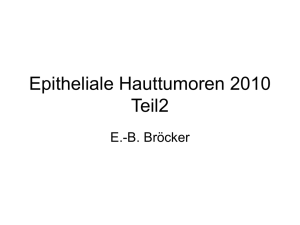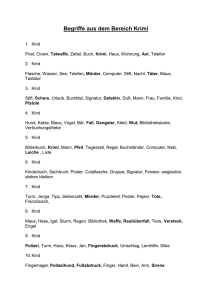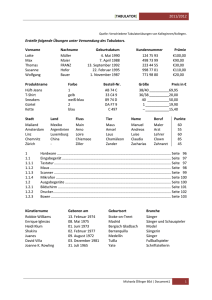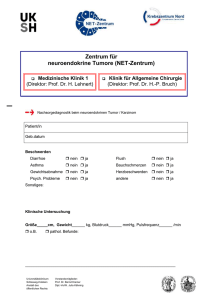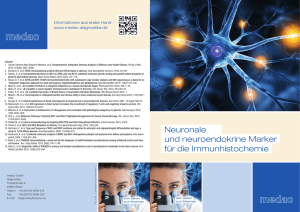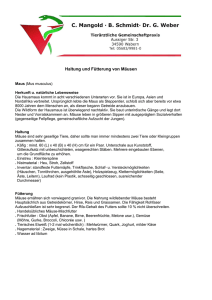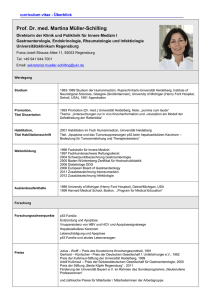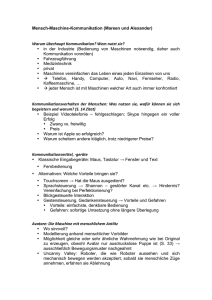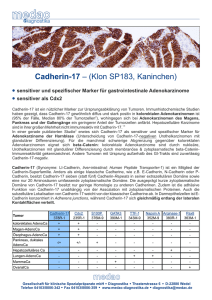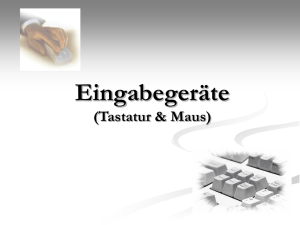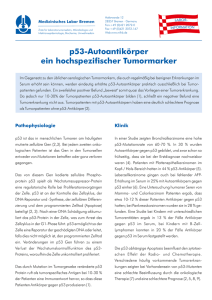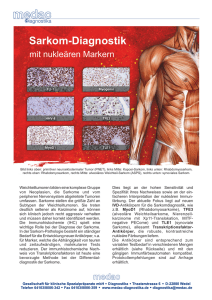OLIG2 Flyer - medac
Werbung
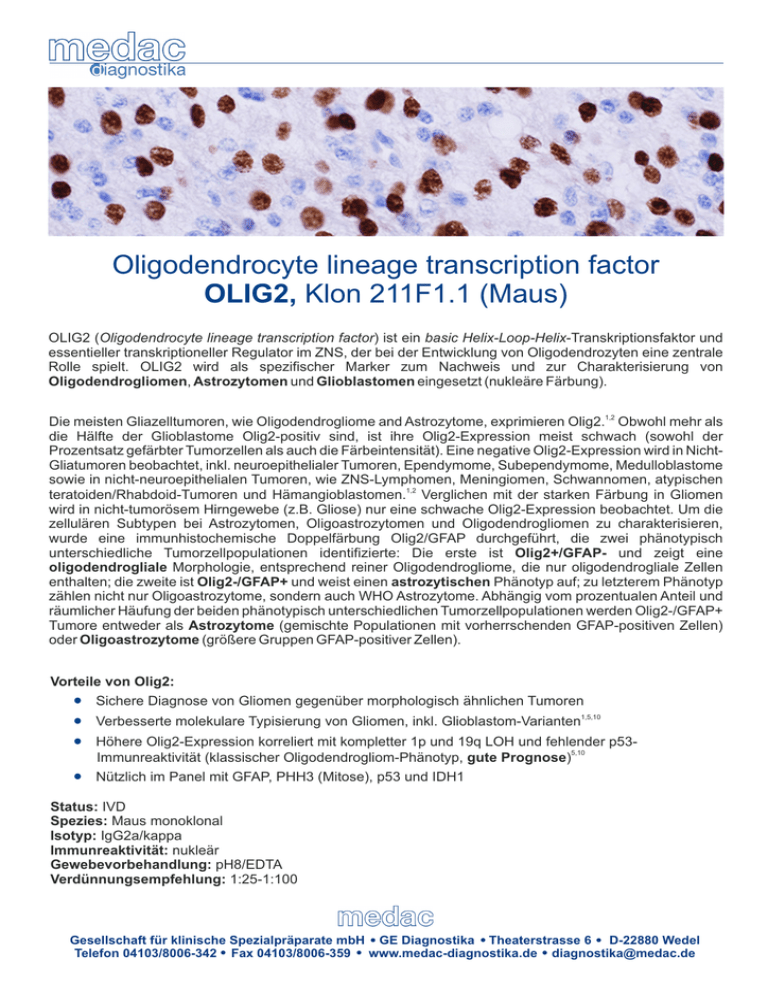
Oligodendrocyte lineage transcription factor OLIG2, Klon 211F1.1 (Maus) OLIG2 (Oligodendrocyte lineage transcription factor) ist ein basic Helix-Loop-Helix-Transkriptionsfaktor und essentieller transkriptioneller Regulator im ZNS, der bei der Entwicklung von Oligodendrozyten eine zentrale Rolle spielt. OLIG2 wird als spezifischer Marker zum Nachweis und zur Charakterisierung von Oligodendrogliomen, Astrozytomen und Glioblastomen eingesetzt (nukleäre Färbung). 1,2 Die meisten Gliazelltumoren, wie Oligodendrogliome and Astrozytome, exprimieren Olig2. Obwohl mehr als die Hälfte der Glioblastome Olig2-positiv sind, ist ihre Olig2-Expression meist schwach (sowohl der Prozentsatz gefärbter Tumorzellen als auch die Färbeintensität). Eine negative Olig2-Expression wird in NichtGliatumoren beobachtet, inkl. neuroepithelialer Tumoren, Ependymome, Subependymome, Medulloblastome sowie in nicht-neuroepithelialen Tumoren, wie ZNS-Lymphomen, Meningiomen, Schwannomen, atypischen teratoiden/Rhabdoid-Tumoren und Hämangioblastomen.1,2 Verglichen mit der starken Färbung in Gliomen wird in nicht-tumorösem Hirngewebe (z.B. Gliose) nur eine schwache Olig2-Expression beobachtet. Um die zellulären Subtypen bei Astrozytomen, Oligoastrozytomen und Oligodendrogliomen zu charakterisieren, wurde eine immunhistochemische Doppelfärbung Olig2/GFAP durchgeführt, die zwei phänotypisch unterschiedliche Tumorzellpopulationen identifizierte: Die erste ist Olig2+/GFAP- und zeigt eine oligodendrogliale Morphologie, entsprechend reiner Oligodendrogliome, die nur oligodendrogliale Zellen enthalten; die zweite ist Olig2-/GFAP+ und weist einen astrozytischen Phänotyp auf; zu letzterem Phänotyp zählen nicht nur Oligoastrozytome, sondern auch WHO Astrozytome. Abhängig vom prozentualen Anteil und räumlicher Häufung der beiden phänotypisch unterschiedlichen Tumorzellpopulationen werden Olig2-/GFAP+ Tumore entweder als Astrozytome (gemischte Populationen mit vorherrschenden GFAP-positiven Zellen) oder Oligoastrozytome (größere Gruppen GFAP-positiver Zellen). Vorteile von Olig2: · Sichere Diagnose von Gliomen gegenüber morphologisch ähnlichen Tumoren · · · Verbesserte molekulare Typisierung von Gliomen, inkl. Glioblastom-Varianten1,5,10 Höhere Olig2-Expression korreliert mit kompletter 1p und 19q LOH und fehlender p53Immunreaktivität (klassischer Oligodendrogliom-Phänotyp, gute Prognose)5,10 Nützlich im Panel mit GFAP, PHH3 (Mitose), p53 und IDH1 Status: IVD Spezies: Maus monoklonal Isotyp: IgG2a/kappa Immunreaktivität: nukleär Gewebevorbehandlung: pH8/EDTA Verdünnungsempfehlung: 1:25-1:100 Gesellschaft für klinische Spezialpräparate mbH GE Diagnostika Theaterstrasse 6 D-22880 Wedel Telefon 04103/8006-342 Fax 04103/8006-359 www.medac-diagnostika.de [email protected] Olig2 387M-1 GFAP 258M-1 S-100 330M-1 EMA 247M-9 +/- + + - +/- + + - Oligodendrozytom + -/- - - Ependymom - +/- + - Glioblastom +/- +/- + - Meningiom (+)/- +/- -/+ + Tumore Pilozytisches Astrozytom Gemistozytisches Astrozytom konzentriert Antikörper EMA GFAP PHH3 p53 p53 OLIG2 S100 Klon Spezies E29 Maus G-A-5 Maus polyklonal Kaninchen DO7 Maus SP5 Kaninchen 211F1.1 Maus 4C4.9 Maus gebrauchsfertig/RTU Verdünnung 0,1 ml 0,5 ml 1,0 ml 1 ml 100-500 50-200 100-500 100-500 25-100 25-100 50-200 247M-94 258M-14 369A-14 453M-94 453R-14 387M-14 330M-14 247M-95 258M-15 369A-15 453M-95 453R-15 387M-15 330M-15 247M-96 258M-16 369A-16 453M-96 453R-16 387M-16 330M-16 247M-97 258M-17 369A-17 453M-97 453R-17 387M-17 330M-17 7 ml 25 ml 247M-98 247M-90 258M-18 369A-18 453M-98 453R-18 387M-18 330M-18 330M-10 Referenzen Olig2 (Pathologie): 1. Joseph NM, et al. Diagnostic implications of IDH1-R132H and OLIG2 expression patterns in rare and challenging glioblastoma 2. 3. 4. 5. 6. 7. 8. 9. 10. 11. 12. 13. 14. variants. Mod Pathol 2013; 26: 315-326. Matsumura N, et al. Olig2-positive cells in glioneuronal tumors show both glial and neuronal characters: The implication of a common progenitor cell? Neuropathology 2013 in press. Otero JJ, et al. OLIG2 is differentially expressed in pediatric astrocytic and in ependymal neoplasms. J Neurooncol 2011; 104: 423-438. Okada M, et al. Olig2 is useful in the differential diagnosis of oligodendrogliomas and extraventricular neurocytomas. Brain Tumor Pathol 2011; 28:157-161. Durand KS, et al. 1p19q LOH patterns and expression of p53 and Olig2 in gliomas: relation with histological types and prognosis. Mod Pathol 2010; 23: 619-628. Ishizawa K, et al. Olig2 and CD99 are useful negative markers for the diagnosis of brain tumors. Clin Neuropathol 2008; 27: 118128. Preusser M, et al. OLIG2 is a useful immunohistochemical marker in differential diagnosis of clear cell primary CNS neoplasms. Histopathology 2007; 50: 365-370. Mikami S, et al. Predominant expression of OLIG2 over ID2 in oligodendroglial tumors. Virchows Arch 2007; 450: 575-584. Rhee W, et al. Quantitative analysis of mitotic Olig2 cells in adult human brain and gliomas: implications for glioma histogenesis and biology. Glia 2009; 57: 510-523. Mokhtari K, et al. Olig2 expression, GFAP, p53 and1p loss analysis contribute to glioma subclassification. Neuropathol Appl Neurobiol 2005; 31:62-69. Ligon KL, et al. The oligodendroglial lineage marker OLIG2 is universally expressed in diffuse gliomas. J Neuropathol Exp Neurol 2004; 63: 499-509. Yokoo H, et al. Anti-human Olig2 antibody as a useful immunohistochemical marker of normal oligodendrocytes and gliomas. Am J Pathol 2004; 164: 1717-1725. Ohnishi A, et al. Expression of the oligodendroglial lineage-associated markers Olig1 and Olig2 in different types of human gliomas. J Neuropathol Exp Neurol 2003; 62: 1052-1059. Marie Y, et al. OLIG2 as a specific marker of oligodendroglial tumour cells. Lancet 2001; 358: 298-300. Referenzen Olig2 (Biologie): 15. 16. 17. 18. Yates D. Development: directing development through phosphorylation. Nat Rev Neurosci 2011; 12: 248-249. Gaber ZB, Novitch BG. All the embryo's a stage, and Olig2 in its time plays many parts. Neuron 2011; 69: 833-835. Sun Y, et al. Phosphorylation state of Olig2 regulates proliferation of neural progenitors. Neuron 2011; 69: 906-917. Li H, et al. Phosphorylation regulates OLIG2 cofactor choice and the motor neuron-oligodendrocyte fate switch. Neuron 2011; 69: 918-929. 19. Mehta S, et al. The central nervous system-restricted transcription factor Olig2 opposes p53 responses to genotoxic damage in neural progenitors and malignant glioma. Cancer Cell 2011; 19: 359-371. Gesellschaft für klinische Spezialpräparate mbH GE Diagnostika Theaterstrasse 6 D-22880 Wedel Telefon 04103/8006-342 Fax 04103/8006-359 www.medac-diagnostika.de [email protected] REA_D73_Olig2 - 04/2013 che
